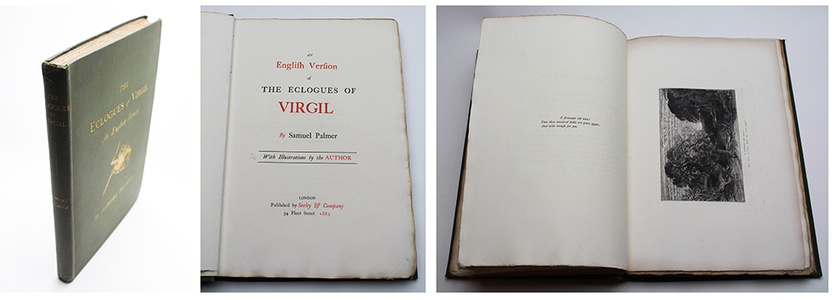| Method | |
| Artist | Samuel Palmer |
| Published | London. Published by Seeley & Company, 54 Fleet Street 1883. |
| Dimensions | Folio. 330 x 230 mm |
| Notes |
First edition. Publisher's green cloth binding with gilt-tooled titles on spine and front board and gilt-stamped device of bucolic hat and pitchfork below title. Half title and title page in black and red. xv, 102pp, plus 14 black and white plates and accompanying facing pages in letterpress. Light scuffing to boards, spine bumped at top and bottom, foxing to endpapers, otherwise fine. Decorative bookplate for Percival Gaskell to front pastedown. The first edition of Samuel Palmer's English translation of the Eclogues of the 1st century BC Roman poet Publius Vergilius Maro (Virgil). Palmer had begun working on an English edition of Virgil almost thirty years before the publication of this volume, lamenting in 1872 that he wished Blake were still alive to produce decorative headpieces for each of the ten eclogues. Instead, he began producing a series of etchings of his own to accompany the translation, though at the time of his death in 1881 only one was complete, though another four were far enough progressed that they were completed by Palmer's son, Alfred Herbert Palmer. Another nine, planned as either sketches or watercolours, were reproduced in facsimile for this posthumous edition. Alongside the current popular example, bound in green cloth, the publishers also issued a large paper edition bound in vellum and limited to 135 numbered copies. Samuel Palmer (1805 – 1881) was a visionary artist and contemporary of William Blake. A key figure in British Romanticism he was also a prolific writer as well as a watercolourist, etcher and printmaker. Palmer is best known for his early works executed at Shoreham where he lived between 1826 to 1835. Introduced to William Blake by John Linnel (whose daughter he would later marry) Palmer and artists George Richmond and Edward Calvert formed a group named The Ancients who were characterised by their admiration for the work of William Blake and their attraction to archaism in art. Like many great artists, it was not until after death that the works of Samuel Palmer were rediscovered and finally afforded the attention they deserved. Although his watercolours were popular in England at the time, Palmer struggled financially throughout his life time and had to divert much of his attentions to teaching to support himself and his wife, Hannah Linnel. After his death in 1881, Samuel Palmer was largely forgotten, his surviving son, Alfred Herbert Palmer, even went as far as to burn a large portion of his fathers work in 1901, stating that: "Knowing that no one would be able to make head or tail of what I burnt; I wished to save it from a more humiliating fate". In 1926 Martin Hardie curated a show at the Victoria and Albert Museum entitled Drawings, Etchings and Woodcuts made by Samuel Palmer and other Disciples of William Blake. This kick-started the revival of interest in Palmer's work which subsequent retrospective exhibitions and publications have continuously reinforced throughout the rest of the 20th century. The Shoreham work in particular has had a notable influence on several important 20th century artists such as Frederick Landseer Griggs, Robin Tanner, Graham Sutherland, Paul Drury and Eric Ravilious. Percival Gaskell (1868-1934) was a British landscape painter, etcher, mezzotinter, and art historian. |
| Framing | |
| Price | £1,300.00 |
| Stock ID | 52725 |

